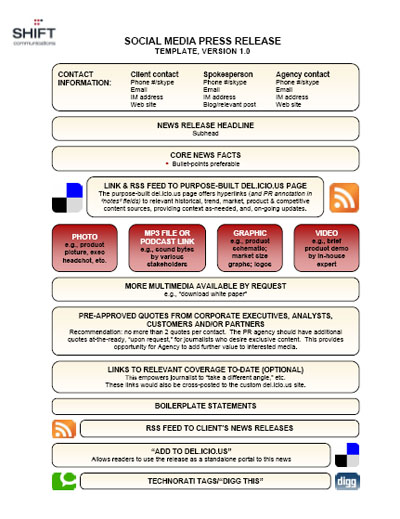In my previous post (PR 2.0 bloggers, and the use of Social Media strategies) I’ve tried to make the case that a shift is happening, especially visible among the younger generations, from a pushing- to a pulling media climate. On the internet people are now less interested in just reading news or have it pushed to them, they want to interact with it, influence it, they want to shape opinions about what others read (especially within their peer groups). Several of the most popular sites on the web are now social media websites, like My Space, Facebook, YouTube, Digg and Blogger. Many traditional journalists nowadays also use the internet to a higher extent, checking out forums and blogs, for story insights and ideas.
The Social media Release
PR 2.0 deals with how PR can take into account and employ this increased social media which exist today, such as blogs, Webinars, podcasts, vlogs etc. A Social Media Release (SMR) is a new variant of the traditional press release for online distribution, which incorporates the elements of PR 2.0. Simply put the SMR contain concise information presented through text and multimedia content shared via social networks. It also includes links (see my post Push- and pull-media) to different sources of information which could be relevant to writing a good story, making it as easy as possible for journalists to pull the necessary information needed to write about the subject matter. For it to be an authentic Social Media it also incorporates the possibility for a two way dialogue between the reader and sender.
Development of the SMR content and layout
The journalist Tom Foremski (former Financial Times writer) wrote an article in the Silicon Valley Watcher titled Die! Press Release! Die! Die! Die! in February 2006. He argued that the traditional press release in many instances was ineffective, and called for action and change. Following this Todd Defren produced the first template for a Social Media Release in May 2006.

This template is still widely used, but in the beginning of 2008 the newswire service company MarketWire released its ‘Social media 2.0’.

The latest development has been that The Society for New Communication Research (SNCR) together with The International Association of Business Communicators (IABC) and several leading profiles on the Social Media scene, will lead a workgroup aiming among other things to define a standard for the SMR.
Distribution
Just like with the traditional press release wire services are often used for distribution, like Marketwire in the US and WebitPR in the UK. In combination with this search engine optimization (SEO) of different sort is important for the SMR to be findable via searches on such places as Reuters, Google News, Yahoo News and for the different elements within the SMR to be findable at relevant places (Audio podcast at Apple i-tunes, video at YouTube etc.). For maximum impact the SMR can also be published on a company’s blog set up via Wordpress or Blogger, and can then be found through blog-specific search engines like Technorati, BlogPulse, Google Blog Search etc. as well. Then a separate social media optimization (SMO) or blog search engine optimization (BSEO) process is required.
Some problems
1) If distributed via a wire service it may appear differently depending upon where it is viewed, there is a lack of control over the appearance. 2) To produce audio and video can be costsome, especially for smaller companies. 3) Giving the option for two way communication in the SMR may be time consuming for the public relations officer if he/she has to spend time answering or discussing. Also if the replies are not filtered before appearing on a company’s online newsroom, bashing of the company in question may occur.
Reflection
As the media climate is changing and information-pulling and participation in creating information is increasing, I do believe the SMR can be an effective tool in the PR practitioner’s toolbox. It is however just one tool and needs to be used alongside other tools and approaches in a campaign, including the traditional press release, to form an effective strategy and achieve the desired results. Also, as with the traditional press release, it still needs to be well written to have any impact at all. I agree with Brian Solis, one of the main figures behind the SMR, when he states the following in his post The Definitive Guide to Social Media Releases:
“I am so pleased and excited that the PR industry is interested in something new to help reach journalists, bloggers and their customers…But, I’m sorry to say, that just because a new tool is available to you, you still have to make your story interesting, relevant, and newsworthy. The Social Media Release is not going to miraculously fix a hyperbole-ridden, over-stated, incomprehensible document riddled with BS. The people that matter to you are simply seeking context, relevance, what’s new, what you do, why it matters, how it’s different, and to whom. You still have to do your homework and write something compelling and clear.”



.jpg)